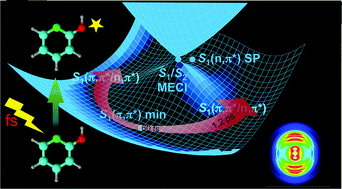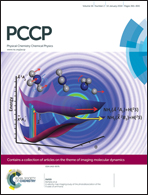A roaming wavepacket in the dynamics of electronically excited 2-hydroxypyridine†
Abstract
How much time does it take for a wavepacket to roam on a multidimensional potential energy surface? This combined theoretical and pump–probe femtosecond time experiment on 2-hydroxypyridine proposes an answer. Bypassing the well-established transition state and conical intersection relaxation pathways, this molecular system undergoes relaxation into the S1 excited state: the central ring is destabilized by the electronic excitation, within ∼100 fs after absorption of the pump photon, then the H-atom bound to oxygen undergoes a roaming behavior when it couples to other degrees of freedom of the molecule. The timescale of the latter process is measured to be ∼1.3 ps. Further evolution of the wavepacket is either an oscillation onto the S1 potential or a conversion into the triplet state for timescale larger than ∼110 ps. Our work introduces a new tool for the understanding of time-resolved relaxation dynamics applied to large molecules through the roaming dynamics characterized by its strongly delocalized wavepacket on flat molecular potential energy surfaces.

- This article is part of the themed collection: Imaging molecular dynamics

 Please wait while we load your content...
Please wait while we load your content...